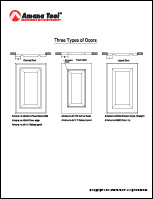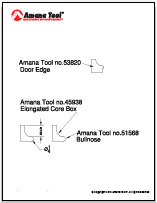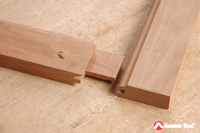I would like to make my own cabinet doors now-raised panel/cope and stick. Could you suggest some classic profiles and also the dimensions of the components to mill? That is, the typical thickness and width of the stile/rail and panel to begin milling with. And how do you size these elements for a given opening in a face frame type cab?
Thanks.
Antioch, CA
-Ron
Our Expert

Cabinet doors are typically constructed with a stile-and-rail framework surrounding a "raised panel" (the edges of the panel have a decorative bevel which fit within the groove in the frame). This is a centuries-old construction method that allows the panel to expand and contract seasonally while the outer dimensions of the door remain unchanged.
The stiles run in a vertical direction and the horizontal rails fit between the stiles.
The stock for the stile-and-rail framework is typically 3/4" to 7/8" thick; panels are typically 5/8" thick. These standards have actually been used for centuries and today's router bits and shaper cutters are designed to use these same dimensions.
The width of the stiles and rails on kitchen cabinet doors vary based upon the design and are typically sized from 2" to 3" in width.
Cabinet doors can be designed to fit the cabinet in one of three ways:
1. Flush or Inset--Flush fitting doors must be carefully sized to fit within the cabinet opening. The is a traditional cabinet and door that has made a comeback in recent years and is my personal favorite. To join the stiles and rails I use traditional deep mortise-and-tenon joints. As you can see in the drawing, I add a decorative corner bead to the inside edges with Amana corner bead bit no. 54170 (see the article on the Amana website for techniques for mitered sticking). The no. 54117 traditional raised panel bit completes the look. Although it is labor intensive to fit and hinge inset doors, this style of door is beautiful and worth the extra effort.
2. Lipped--Lipped doors have a rabbet around the door perimeter and when closed, most of the door thickness is inside of the cabinet. This is also a
traditional door and it less work to fit than inset doors. To cut the joints on this door I recommend Amanano. 55439 Mission Style stile-and-rail bit set. The door edges are lipped with the Amana no. 55300.
3. Overlay--Walk through any home center and look at the display cabinetsand this is the style that you will see. Overlay doors are popular because they are quick and easy to install. In fact, an overlay door does not really fit the cabinet opening, it simply covers the opening. However, with the right combination of profiles overlay doors can provide a striking appearance to a new kitchen. For the door in this drawing I recommend the Amana no.55430 Ogee Stile-and-Rail, the no. 49534 Door Edge and theno. 54121 Raised Panel bit. Notice that all three of these profiles are a variation of the classic reverse curve ogee.
As you can see from the three designs that I've offered, by using different combinations of stile-and-rail profiles, raised panel profiles, and door edges the possibilities are virtually endless. And Amana Tool offers one of the most complete lines of door making router bits available anywhere.





 Cabinet doors are typically constructed with a stile-and-rail framework surrounding a "raised panel" (the edges of the panel have a decorative bevel which fit within the groove in the frame). This is a centuries-old construction method that allows the panel to expand and contract seasonally while the outer dimensions of the door remain unchanged.
Cabinet doors are typically constructed with a stile-and-rail framework surrounding a "raised panel" (the edges of the panel have a decorative bevel which fit within the groove in the frame). This is a centuries-old construction method that allows the panel to expand and contract seasonally while the outer dimensions of the door remain unchanged. 
 Amana now has two cabinet door making bit sets which feature strong mortise-and-tenon joinery and coped sticking. Tools no
Amana now has two cabinet door making bit sets which feature strong mortise-and-tenon joinery and coped sticking. Tools no
 Yes, the Amana no.
Yes, the Amana no.